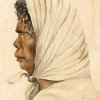Koori people & farmers conflicts
North Coastal - 1804
An increase in number of conflicts when the “maize was ripe”. Farming has largely prevented access to the river for food gathering for the Aboriginal people. Many are starving. The Koori view of life is that food is there to be gathered, in one’s own country, and the ripe corn has replaced the wild daisy yams that have grown on the river banks. Many farmers use Aboriginal labour to help them gather crops but fail to pay them adequately for their work. If Koori people cross farmers’ land they are liable to be shot at. Governor King hears testimony from three Koori men that if they can retain certain places on the lower Hawkesbury, they will be satisfied and not in trouble the farmers. King rashly assures them that no more settlements will be made lower down the Hawkesbury – north-coastal country. (Historical Records of New South Wales, vol 5, p. 513)
Reports on 24 June 1804 of 150 Aborigines who strip farms of crops, poultry, clothes and goods; spears are thrown at a settler who opposes them. (Sydney Gazette, 24 June 1804)
An old Koori man is Grewin living on Dangar Island in the Hawkesbury (Mullet Island). Some ex-convicts salt boiling on the island, are attacked and their clothing taken by Koories. Two other friendly Koories escort the men back to Sydney unharmed. (Swancott 1967, p. 14)
James Webb’s boat again attacked by Aboriginal warriors led by Woglomigh. Woglomigh is known to the colonists as “notorious”.
Newspaper Sydney Gazette reports Aboriginal people on a beach saving crew from the sinking ship Speedwell near Lion Island. “The very humane, friendly and precautionary conduct of an ancient native … would reflect the highest credit to a polished member of civilized society”. (Sydney Gazette)

